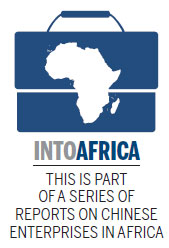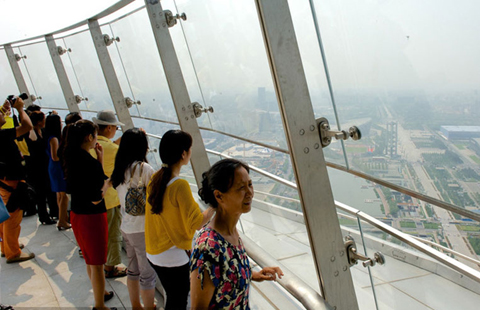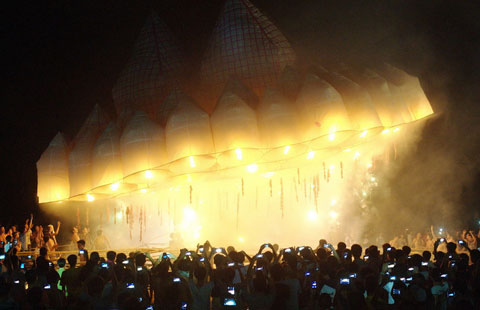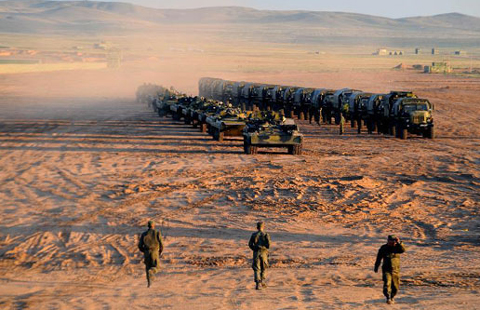
Building a $500m plant in a remote part of Ethiopia presented one of China's major engineering enterprises with a sack full of challenges
In four months, a modern cement plant, built to full European standards, will be put into operation on a remote Ethiopian plateau.
The trail-blazing $500 million facility is being funded by Nigeria's Dangote Group, using Chinese expertise.
|
Chinese and Ethiopian workers build a cement plant in an isolated village in Ethiopia. The facility is funded by Nigeria's Dangote Group. Photos by Fu Jing / China Daily |

"This is the toughest job I have ever taken on in my 20 years of building factories," says Han Mingfa, general manager of the Ethiopia branch of Sinoma International Engineering, one of China's leading large-scale industrial plant builders and planners.
The facility sits in Ethiopia's Oromia region - an hour and half drive from the capital, Addis Ababa - about 2,600 meters above sea level.
Driving to the site, the surrounding landscape is high, rugged mountains, undulating plateaus, panoramic gorges, and deep river valleys.
Much of the limestone to be used in the cement production process will come from those valleys.
"That's why the owner chose to build here, but it is challenging to build such a modern plant in a landlocked country," says Han, whose company is also building cement production lines in other African countries for Dangote.
Han first arrived in Muger Town, in Oromia, in May 2011 to research possible sites for the future plant.
Its exact location depended on a variety of logistical and environmental conditions, such as local taxation and labor costs, and the best sources of raw materials. Building started in July the following year.
Han's first impression of the region was how "remote" it was, but also how "stunningly beautiful".
Since joining Sinoma in 1995 after graduation, he had previously built production lines on the outskirts of cities or towns.
"This was a big contrast. We have had to work in remote, poor villages, which presented us with a lot of challenges," he says, adding that the level of development in the region is at least 20-30 years behind those even in rural parts of China.

Sinoma's contract covered engineering design, equipment supply, civil construction, equipment installation, commissioning, training and performance testing.
The limestone is mined, then transported using long surface conveyor belts to the new plant, which has a perimeter of 6.5 kilometers.
With its cement production line now taking shape, Han is confident the operation can be up and running by the end of the year. Its five massive raw materials storehouses are already built.
Most of the components used on the production line have had to come from China, including more than 400 streetlights now being used to illuminate the area.
Workers have been cutting tracks through mountains, ready to transport enough limestone from 10 km away, via the conveying belt, to satisfy the plant's 6,000-ton daily cement output.
"Though very, very hard work, we have been running at full capacity to hit our deadline," says Han, during a tour of the muddy construction site.
He adds there have been many hurdles since the project started in earnest in 2012, none more so than coping with the weather. Ethiopia's wet season runs from June to September, bringing heavy, daily rain.
Another major challenge was transporting sometimes heavy components from China.
The parts arrived after 25 days at sea into the port of Djibouti, to the west. But it could take another two months to get them the 1,000 km from there to the site by road, even traveling by night.
The roads are narrow and rugged, and clearing the port sometimes is hampered by complicated customs clearance procedures.
"In China, drivers could have managed that distance overnight," says Han.
He adds that the unpredictability of delivery times often is compounded by tricky work schedules on site.
Ethiopia has limited local heavy industrial supplies, and practically all of the components had to be imported.
During construction, a total of 180,000 tons of equipment had to be shipped from China.
The heaviest and bulkiest of those, the 150-ton cement mills, could take three months to arrive by road from Djibouti. The mills are used to pulverize hard lumps of clinker, an ingredient of cement made of limestone and other materials.
Han says not only was it difficult to find vehicles big enough to transport the components, but the larger parts could only be moved at night when the roads were empty, and they still needed police escorts all the way.
Despite his company having experience in building cement plants around the world, using different international standards and practices, he admits communication with the project owner and local government was sometimes tough.
Local regulations required lengthy paperwork for some procedures, which would be orally agreed upon back home.
But in spite of the difficulties, he says he was happy with the way the project progressed, and with being able to offer so much work locally.
During peak times, the company employed 1,500 workers on-site and in building the conveyer, and 800 assembling the production line.
"They are mainly farmers but we gave them training, which I hope might change many of their lives," adds Han.
The work has allowed him to forge close and lasting relationships with local subcontractors, which should prove useful in landing further Ethiopian and African contracts for Sinoma International.
Teshome Lemma, the Ethiopian representative of the Dangote Group, says the plant's construction will help to satisfy the country's growing need for cement.
"This represents a big foreign investment for Ethiopia, but the construction has also allowed a process of exchanging experience and knowledge with China, which has brought a lot of added value," says Lemma, particularly in chemical, mechanical, processing and management skills.
He adds that once fully operational, the plant will create about 5,000 direct or indirect jobs, and he is confident there will no adverse effects on the local environment, given the factory will be fully compliant with the strictest European emission standards.
Han says he still faces challenges during trial operations.
"On such a massive production line, it's common for problems to occur during the trial period, such as urgent parts being needed from China.
"But we are confident everything will go smoothly."
fujing@chinadaily.com.cn
(China Daily Africa Weekly 08/15/2014 page21)








